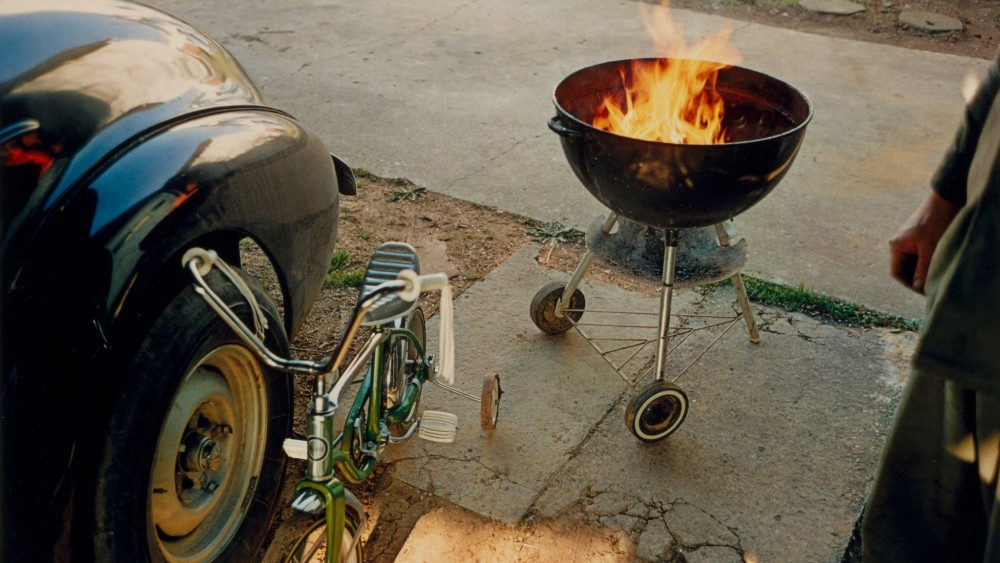
William Eggleston: The Last Dyes
David Zwirner is pleased to present The Last Dyes, an exhibition of new dye-transfer prints by William Eggleston opening at the gallery’s 606 N Western Avenue location in Los Angeles. Eggleston pioneered the use of dye-transfer printing for art photography in the 1970s, and—as the title suggests—these photographs will be the final prints ever made of Eggleston’s images using this analog process. The presentation itself constitutes the last major group of photographs ever to be produced using this printing method, making it a unique opportunity to see a number of works by Eggleston in the format in which he originally presented them.
The works on view are from Eggleston’s celebrated Outlands and Chromes series, as well as several images that were first shown in the artist’s groundbreaking exhibition of color photography at The Museum of Modern Art, New York, in 1976, and the concurrent publication William Eggleston’s Guide. Eggleston, in consultation with his sons William and Winston, chose this group of images for his final dyes as a representative selection of the immense photographic project he undertook between 1969 and 1974 during his travels through the American South and West. In 1972, Eggleston discovered the dye-transfer process that allowed him to achieve the richness of tonal depth and color saturation that he had been searching for.
Developed by Kodak in the 1940s, the dye-transfer process and materials were primarily used for fashion photography and commercial use. More akin to offset printing, the dye-transfer process is a technically advanced undertaking done by hand in which the original image (Eggleston primarily used Kodachrome slide film) is split into three separation negatives that are then enlarged onto three film matrices—a transparent cell coated with a light-sensitive emulsion—as positive images. Each of the three film matrices is immersed in a dye bath of cyan, magenta, and yellow, respectively, with the gelatin on the matrices holding the dye. One at a time, the individual matrices are pressed and rolled onto a special fiber paper that is highly receptive to the dyes, resulting in the final color photograph.
In the early 1990s, Kodak stopped producing the dyes, paper, and the Matrix film used in the process. At that time, Eggleston and the renowned dye-transfer specialists Guy Stricherz and Irene Malli—who have printed Eggleston’s works for the last twenty-five years—began acquiring the remaining available dye-transfer materials, using the last significant quantities of them to produce these final photographs.
The images that were selected for The Last Dyes testify to this special pairing of artist and medium, and serve as a showcase for Eggleston’s ability to visually grasp and subsequently isolate and capture the unique qualities of color and light. In many of the landscapes and exteriors, Eggleston manifests the vastness of the Southern sky within the confines of the rectangular image field, bringing together verdant green expanses and run-down built structures underneath streaking cirrus and cumulus clouds. Signs and cars stand like blocks of color against the tonal gradations of skies shot at various times of day. People, too, become vehicles for color—visual components within the compositions—and also serve as emblems of the time and place in which Eggleston encountered them.
The Last Dyes also includes interiors in which the contrast between the highlights and darkest shadows have a baroque-like tenebrism—palpable blacks with more brightly lit figures or objects situated within them. One such work, a self-portrait, sees Eggleston lying down in a darkened room with his head on a bright white pillow whose folds appear like supple carved marble. Resting close to the camera’s lens, the artist’s staring face and oversized hand are similarly sculptural in appearance. The scene evokes the sacral light of a baroque church interior and exudes a sense of calm familiarity that befits the surroundings—perhaps a motel—in which Eggleston took the photograph.
Balancing formal, chromatic, and compositional sophistication with poignant portrayals of these real lived worlds and the people who inhabit them, these dye-transfer prints appear as vibrant and alive today as the scenes themselves were when Eggleston photographed them some fifty years ago.
William Eggleston: The Last Dyes is presented as part of PST ART: Art & Science Collide, a landmark regional event exploring the intersections of art and science, both past and present. PST ART is presented by Getty.